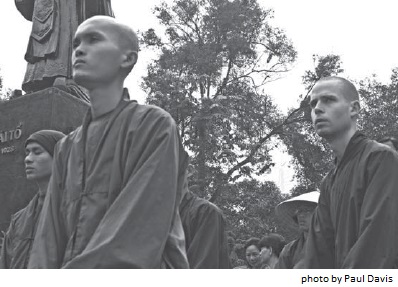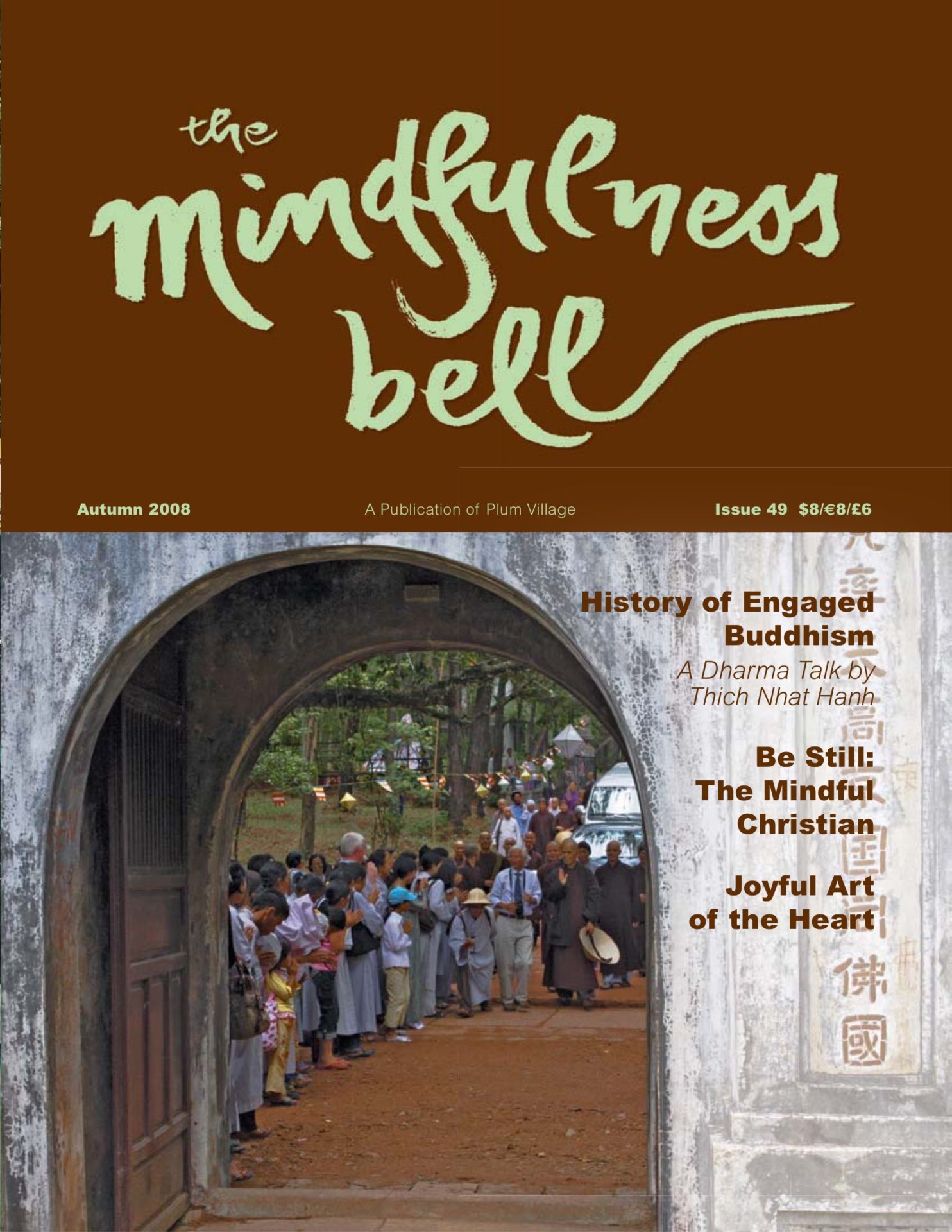By Sister Annabel Laity in October 2008

Before the Sangha traveled to Vietnam, Thay wrote a code of conduct for monks with regards to nuns, to update the ancient code of conduct for nuns with regards to monks. Sister Annabel graciously wrote this commentary for the Mindfulness Bell.
The Sangha of the Buddha is known as the Fourfold Sangha.
By Sister Annabel Laity in October 2008

Before the Sangha traveled to Vietnam, Thay wrote a code of conduct for monks with regards to nuns, to update the ancient code of conduct for nuns with regards to monks. Sister Annabel graciously wrote this commentary for the Mindfulness Bell.
The Sangha of the Buddha is known as the Fourfold Sangha. It comprises bhikshus (fully-ordained monks), bhikshunis (fully-ordained nuns), laymen, and laywomen. The bhikshuni component of the Sangha was added last of all.
Tradition has it that it was not an easy matter for women to be accepted as monastic members of the Sangha. If the tradition, which says that the Buddha hesitated in receiving women as monastic disciples, is true, it is not something difficult to understand.
Surely the Buddha must have been taken by surprise when his dear aunt and a large number of Sakyan ladies arrived in Vaishali with swollen and bleeding feet after walking hundreds of miles barefoot to prove that women too could lead the life of wandering monks? No doubt he was also moved. His aunt Mahagotami had previously asked permission to ordain as a nun when the Buddha was in Kapilavastu and had been told that the time was not yet right for women to ordain.
It was not that the Buddha saw women as of inferior intellectual or spiritual properties that he hesitated to allow them to follow the monastic vocation. The reservations of the Buddha had to do with the cultural and social situation in which the Sangha of his time found itself.
Concerns of the Buddha
First of all the Buddha wanted his disciples to have the best conditions to realize the practice. His monk disciples spent the night at the foot of trees and begged for alms in the towns and villages. This could have been very dangerous for women to do. According to the Indian custom of that time women were always to stay in a house where they were under the protection of their father, husband, elder brother, or son. The only women who did not have that protection were courtesans and loose women. The Buddha feared that his nun disciples would be branded as such and in fact this often happened. It also happened that on a couple of occasions when nuns unusually stepped out of the monastery alone they were sexually assaulted.
The second question the Buddha must have asked himself was how the monks he had already ordained would accept nuns as fellow members of the same spiritual family. Were the monks sufficiently free of their cultural and social prejudice to offer protection to nuns and support them in their practice?
The third question for the Buddha concerned the relationship of the nun Sangha to the monk Sangha. The Buddha taught that the recognition of seniority was essential for harmony in the Sangha (Culavagga VI, 6). Westerners should remember that seniority is not hierarchy. Seniority is a matter of protocol and mutual respect but the ways juniors have of showing respect to seniors differ from the ways seniors have of showing respect to juniors. The Buddha made it clear that the nuns were juniors. The nuns after all had had no education. They joined the Sangha after the monks had already been practicing for many years. The monks had already memorized the precepts and discourses of the Buddha. Many had become teachers in their own right. It was only natural that the nuns should show respect to the monks as their seniors.
The Original Gurudharmas
These facts are the basis for the eight original gurudharmas (practices of respect) to be practiced by nuns. They were as follows:
- A bhikshuni should always greet a bhikshu with respect even though she is senior in years of ordination to the bhikshu.
- Bhikshunis should practice the annual three-month Rains’ Retreat in a place where there is a bhikshu Sangha for them to take refuge in and learn from.
- Twice a month the nuns should send a nun (with a second body) to invite the monk Sangha to let them know on what day they should recite the precepts1 and to send them a monk to give them teachings and exhortations concerning their practice.
- At the end of the Rains’ Retreat the nuns have to request shining light from the monks as well as from the other nuns. (This meant that if the monks had seen, heard, and suspected anything untoward in the nuns’ practice they could let the nuns know and give suggestions for the nuns’ practice.)
- If a bhikshuni breaks a Sanghavasesa precept, she has to confess the offense to and be purified of the offense by the bhikshu as well as the bhikshuni Sangha.
- A nun can only receive the full ordination from monks as well as nuns.
- A nun cannot malign or criticize a monk.
- A nun cannot admonish a monk for improper conduct.2
These eight practices of respect have sometimes led people to think that Buddhism discriminates against women. Although there is no small number of individual monks, nuns, and laypeople who believe that to be a woman is a disadvantage for progress on the spiritual path, this is certainly not what the Buddha taught. After the Buddha’s parinirvana, some monks took the opportunity to promulgate their culturally ingrained prejudices. The Buddha said clearly that the fruits of the practice that can be realized by women are no less than those realized by men. In accepting women as nuns the Buddha has opened up a way for hundreds of thousands of women to realize the fruits of the monastic path.
What is needed now is to continue the career of the Buddha by making it clear to Buddhists and non-Buddhists that the bhikshuni Sangha is an equal partner of the bhikshu Sangha in the Buddhist community. The eight gurudharmas for monks that Thay has given us have already been practiced in many Buddhist communities for years. We only need to acknowledge that this is our practice and will continue to be so, so that people no longer have doubts about the status of Buddhist nuns.
Interpreting the New Practices
The first gurudharma for bhikshus is equivalent to that for bhikshunis. Thay has added the fact that each bhikshuni is a representative of the whole bhikshuni Sangha. In bowing to her one is bowing to the whole bhikshuni Sangha. The concept of partnership is also mentioned. It means a spirit of cooperation between monks and nuns in continuing the career of the Buddha.
The second gurudharma for bhikshus is to clarify that it is not a handicap to be a woman. This is an illusion to which women as well as men are subject. Women themselves sometimes also believe that they have been born women because they have not laid down sufficient wholesome roots in past lives.
The third gurudharma for bhikshus is a re-wording of a teaching given by the Buddha (SN IV,3,127). It means that our practice community needs to be a family. Here Thay makes it clear how we can support the members of our spiritual family. Just as the monk practices to see the nun as his mother and so on, so the nun practices to see the monk as her father, brother, or son depending on his age.
The fourth gurudharma for monks is equivalent to the seventh gurudharma for nuns. Thay has added the practice of looking at oneself and at the nun as a bodhisattva. This helps us to recognize the enlightened nature in each other and support wholeheartedly each other’s practice.
The fifth is equivalent to the second gurudharma for nuns. There are mutual advantages for both the bhikshu and bhikshuni Sangha when they practice in proximity to each other.
The sixth is perhaps the most revolutionary. Many monks still hesitate to listen to a nun teaching, let alone invite her to teach them.
The seventh is a continuation of what the Buddha wanted. In the pratimoksha3 there are already precepts forbidding nuns to act as servants to monks. Here we see that in physical work as well as in spiritual practice, the monks are to give the nuns a hand.
The eighth new gurudharma reiterates the need for mutual care and concern if the Sangha is to function as a family.
Sister Annabel, Chan Duc, was abbess of Green Mountain Dharma Center in Vermont. She is currently assisting Thay to establish the European Institute of Applied Buddhism.
1 The precepts had to be recited at the full and new moon. There were no calendars and the educated monks knew how to calculate when the full and new moon days fell.
2 We should know that lay women who were strong in their practice did sometimes admonish monks with the concurrence of the Buddha who also made some precepts for monks at the suggestion of the lady Visakha. This gurudharma is to keep harmony between monks and nuns.
3 The pratimoksha is the disciplinary code of fully-ordained monks and nuns.


